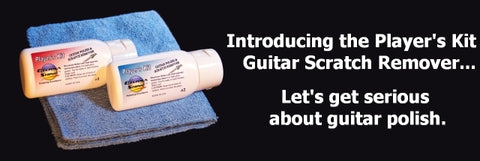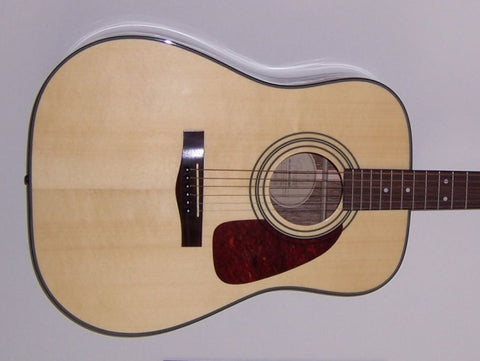It’s time. You’ve been putting off playing guitar and finally you’re ready to take the plunge. You’ve got friends and family that play, and now it’s your turn. But you need a guitar! A little planning can help you avoid costly guitar buying mistakes. Read on, and get our expert tips on what to do (and what not to do!) when selecting your first guitar.

Getting the right guitar is crucial for success, more crucial than the right baseball bat or golf club for those about to swing into action; and the right guitar doesn’t have to cost a lot. Once you own the guitar, the only real upkeep is strings and maybe lessons, because most guitars don’t require much maintenance besides an optional initial setup. Change the strings and avoid climate extremes, and you’re good to go. It’s a pretty inexpensive hobby considering other choices.

The biggest factor in choosing a guitar is comfort and fit, so let’s jump into that as the first of our purchasing tips below.
Tip #1: Size Really Matters
If your new guitar doesn’t feel right or is the wrong size, you won’t want to play it. That’s why it’s crucial to select one with a good fit and body style you can get your arms around in an acoustic guitar. A good salesperson, instructor or fellow musician can make a recommendation here, but here’s a few guidelines. The most common acoustic guitar sold is a large dreadnought shape, this is the typical "cowboy style" guitar you see people strumming on TV or at the beach.

Dreadnought guitars (also spelled 'dreadnaught') have big volume and large bodies but are not easy for everyone to play. If you're barely 5 feet tall, perhaps a large dreadnought shape isn’t your best choice because it may be hard to get your arms around. The same is true for wild shaped or “flying V” style electric guitars.
Just be aware the guitar should feel comfortable when you hold it otherwise the rest of this article wont matter. With many sizes and cool styles out there, you don’t have to get the standard large acoustic guitar because Uncle Joe said so. Almost all guitars can accept lightweight strings or have the string height lowered for comfort (called string "action"), but you can't change the shape of the body. So know that a good fit for your body frame is just as important as any other feature of your new guitar. Concert-type bodies are a great alternative to the classic large body dreadnought. Classical guitars also provide a smaller bodied instrument, with nylon strings. While we're talking about size, many guitars come in different scale lengths or size fractions. You can read up on this online, but here's some quick points: if you're an adult, go with a full size guitar which is called full-scale. This is pretty much true for anyone over age 12. This refers to the length of the neck, not the body shape! For younger students, there are 7/8, 3/4 and 1/2 size guitars. Half-size guitars are quite hard to tune, and really only a good choice for a small child. If possible go with a 3/4 for kids.
Tip #2: The Great Commission
If you’re new to guitars you don't want to go it alone. Relying only on the local music shop’s salesperson for buying advice should never be your sole research experience. Most shops don’t carry all brands and styles, so they’ll be happy to talk you into something that may not be the best fit rather than lose your business. Bringing a guitarist friend helps ensure you get an unbiased informed opinion!

Also, try to find out if the sales staff works on commission. If they do, you can’t rely on an unbiased opinion. Trust me on this! I’ve seen too many cases first hand where commissioned salespeople steer naive customers into a guitar that was best for the salesperson! Certain guitars at the same price-point carry more store profit, so if you don’t know which is best, don’t be surprised if the salesperson recommends the one for which he earns the most! Some big box guitar stores have floor sales people that work entirely on commission.
Tip #3: All Sales Final?
It’s imperative that wherever you buy, the dealer offers a money-back return policy. Many shops, especially smaller stores, have restocking fees or restrictive return policies that aren't always in plain view. In modern times there’s no reason to buy an expensive guitar without a reasonable return policy in case it doesn’t meet your needs. Any store that boasts “All Sales Final” is really saying they could care less about the customer experience and you might want to shop elsewhere. I spent some time in Northern California and got to know a local shop that offered no returns on anything. When asked why, they said "we can't resell it". They had nothing but poor Yelp reviews and the owners were pretty clueless about customer service; it was all about their needs, not the customer.
If you buy online, you may get stuck with costly shipping on a return, and guitars are not cheap to ship, so in effect that limits your return policy. Knowing all of this in advance can assist in where to buy. Think of the last time you saw someone at the return counter in any store arguing with the clerk about the return policy because “they didn’t know”. Don’t be that guy! At that store! Know beforehand.
Tip #4: Price points, and quality
As a general rule, you get a lot better guitar for $250 than $100. As the price climbs higher, quality improves as you approach $500 and up. A $500 guitar might be twice as good as one for $250, but don’t think that a $1000 guitar is always guaranteed to be twice as good as one that costs half that amount. And on it goes. At some point you get "diminishing returns". You can still get a nice instrument for $500 and even less. If you want USA-made and top quality, expect to pay close to $1000. For your first guitar, we feel that $250 is a minimum good starting number for a quality guitar from a dependable dealer; that goes for acoustic and electric guitars. If you can afford more, go for it. Anything less than $200 new is probably very cheap quality and could have problems staying in tune, or neck and playability issues. Of course, buy the most expensive guitar you can comfortably afford. Cheap guitars rarely stay in tune, are usually harder to play and make for a frustrating experience – this all translates to you practicing less.
At some point you get "diminishing returns". You can still get a nice instrument for $500 and even less. If you want USA-made and top quality, expect to pay close to $1000. For your first guitar, we feel that $250 is a minimum good starting number for a quality guitar from a dependable dealer; that goes for acoustic and electric guitars. If you can afford more, go for it. Anything less than $200 new is probably very cheap quality and could have problems staying in tune, or neck and playability issues. Of course, buy the most expensive guitar you can comfortably afford. Cheap guitars rarely stay in tune, are usually harder to play and make for a frustrating experience – this all translates to you practicing less.
Tip #5: The Big Brand Era
Should your first guitar be a Gibson or Fender? That’s up to you, just realize that name brands usually come with a higher price. There are plenty of good brands, some not as well known, that make quality guitars that compete with the household names. This is once again a great reason to bring along a guitarist friend who can tell a good instrument from a lemon. It is possible to get a nice guitar that isn’t a big name company. One nice thing about the name brands, especially the USA ones, is those guitars typically hold their resale value remarkably well. USA built guitars are also usually born of the highest craftsmanship.
Tip #6: Discount and Club Stores - Deal or No Deal?
Costco and Target are places I like to shop, but not for guitars. Typically the musical instruments these stores carry are the cheapest entry-level guitars that are meant as an impulse buy or last minute gift idea for the thrifty, uninformed buyer. These are usually very poorly made Asian manufactured instruments using the skimpiest hardware and assembly techniques. The result is often a glorified toy which rarely stays in tune and may be fine for a temporary guitar, but not as a serious instrument for learning. And you will end up replacing it.  Besides, for only a little more money you can get a much better instrument from a real guitar store that offers service and real advice. Avoid the discount stores (but DO check out the $1.50 jumbo hotdog w/drink, can't beat it!)
Besides, for only a little more money you can get a much better instrument from a real guitar store that offers service and real advice. Avoid the discount stores (but DO check out the $1.50 jumbo hotdog w/drink, can't beat it!)
Tip #7: Electric vs Acoustic – Which one first?
Should you start on electric or acoustic guitar? Believe it or not, electric guitars are easier to play. Period. They are smaller to hold and the strings are easier to press down than an acoustic guitar. You do need an amp and cord but these are readily attained for as cheap as $50. Another alternative is a nylon string or classical guitar. Nylon strings are easier to press down, and make a nice choice for kids wanting an acoustic. Nylon string guitars are another form of acoustic guitars because they don't require amplification. The choice between an acoustic and electric is not as monumental as you may think, because nearly all guitar-playing elements can be applied on both instruments. You can switch at any time and not lose any ground. If you stick with playing guitar, its probably only a matter of time before you own both an electric and acoustic, so it's less of a question of "which guitar I get?” but rather which guitar you get first.
Tip #8: Online, Ebay, Craigslist, and Used?
Unless you are a guitar expert, buying a guitar online has huge disadvantages to in-person. If you go for this option, return policies we discussed (and who pays for return shipping) are even more important. Other outlets like Ebay and Craigslist pose an even higher-risk venture. Just because your brother got a Craigslist killer deal on a like-new computer desk, does not mean you should press your luck there with a used guitar purchase. Ebay and Craigslist are usually legit marketplaces, but some sellers are not. There are fakes and stolen guitars floating around on these venues, because fake and stolen gear can’t be pawned or sold to real guitar stores who screen these instruments by serial number and other safeguards.  Some 'new' guitars listed on these sites are really customer returns or display model/used gear. Not cool. Buying used from a marketplace also can get you a one way ticket to a flawed or broken guitar with limited return options, it's a great place for an unscrupulous seller to unload a bad instrument. For these reasons, only experienced buyers should try their hand here who know the risks. We highly recommend sticking to the usual guitar outlets that offer brand new instruments and walk-in return policies for your first guitar.
Some 'new' guitars listed on these sites are really customer returns or display model/used gear. Not cool. Buying used from a marketplace also can get you a one way ticket to a flawed or broken guitar with limited return options, it's a great place for an unscrupulous seller to unload a bad instrument. For these reasons, only experienced buyers should try their hand here who know the risks. We highly recommend sticking to the usual guitar outlets that offer brand new instruments and walk-in return policies for your first guitar.
9) Do I Really Need a Guitar Warranty?
If it's included, great! But don't put too much weight on a guitar warranty. Most guitar warranties don’t cover things like the finish, electronics, and neck issues, which are where almost all guitar problems exist! Warranties often require you to ship the guitar at your cost to a service center, and once you consider that guitar warranties are really “limited warranties”, very few people ever file guitar warranty claims. Also, guitars usually don’t have many mechanical problems requiring warranty work. If a warranty is included, at least you’ve got one. But don’t put the same stock in it as a vehicle or laptop warranty. Guitars are not like cars or computers; repairs are usually infrequent, inexpensive, and done locally, and guitars can last a lifetime if cared for. That said, there are some companies that do better than others with warranties. Some of the higher-end USA manufacturers like Taylor have excellent warranties and stand behind almost everything on their guitars. But these guitars have higher prices with stricter quality control, so once again you may never take advantage of the warranty! Unless you are spending thousands of dollars on your guitar, the warranty isn’t a big deal. Really. We’ve bought and used hundreds of guitars and never needed a warranty. If you’re really concerned about it, do some research, maybe call a few local shops and ask if they service guitars, and also consider in-house service agreements that some boutique stores or larger chains offer.
So there you have it. A little planning ahead can ward off a bad buying experience. As they say, an ounce of prevention is worth a pound of cure. So turn over a few stones, play some guitars with an experienced friend, choose wisely, and welcome to the world of making your own guitar music! Thanks for reading.
Got a guitar question? Contact us here.
Want a better way to keep your new guitar looking new? Check out our Guitar Scratch Remover Kits and keep your guitar looking it's best:

